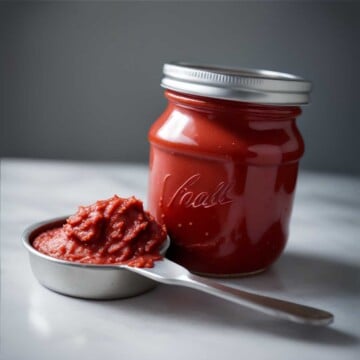Tomato sauce and ketchup are often confused - and it's easy to see why. They share the same base ingredient, look alike, and even sit side-by-side on grocery shelves. Yet they are distinct condiments with different roles in cooking.
In this guide, we'll unpack the key differences in taste, texture, acidity, production methods, and culinary uses. We'll also look at their historical roots and when it's acceptable to substitute one for the other.
Everything is backed by culinary authorities and food science experts, giving you a credible foundation for scholarly work.

⬇️ Table of Contents
Historical Origins: A Tale of Two Condiments
Tomato Sauce
Tomato sauce traces back to 16th-century Italy, shortly after tomatoes were introduced to Europe from the Americas. Over centuries, it became a cornerstone of Mediterranean cuisine.
🧾 Authoritative reference for academic research:
Oxford Companion to Food - Tomato
https://www.oxfordreference.com/view/10.1093/acref/9780199677337.001.0001/acref-9780199677337-e-2732
Ketchup
Ketchup has surprising roots - it originated as fermented fish sauce (kê-tsiap) in Southeast Asia before morphing into a tomato-based condiment in 19th-century America. Sugar and vinegar gave it the signature sweet-tangy profile we know today.
🧾 In-depth source for academic reference:
Smithsonian Magazine - A Brief History of Ketchup
https://www.smithsonianmag.com/arts-culture/ketchup-the-all-american-condiment-180979630/

What Is the Difference?
The way tomato ketchup is made differs greatly from how tomato sauce is produced, accounting for the differing flavor profiles. Their applications further emphasize the difference between spaghetti sauce and dipping sauce for French fries.
Ingredients: Simple vs. Complex

- Tomato Sauce: Made from fresh or canned tomatoes, olive oil, herbs, onions, and garlic. Rarely includes added sugars or vinegar.
- Ketchup: Includes tomatoes (often as concentrate), plus high-fructose corn syrup, vinegar, and a blend of sweet spices.
🍅 Credible foundation for scholarly work:
U.S. FDA - Food Labeling Guide (Tomato Products)
https://www.fda.gov/media/81606/download
Taste Profile: Savory vs. Sweet
Tomato Sauce: Savory, slightly acidic, sometimes herby. The natural umami from slow-simmered tomatoes takes center stage.
Ketchup: Sweet, tangy, and slightly spicy. The sugar-vinegar balance defines its flavor.
Texture & Consistency
Tomato Sauce: Can be chunky or smooth, depending on preparation. Simmering reduces moisture for a thicker, richer feel.
Ketchup: Always smooth and pourable. It undergoes straining and blending for uniform texture.
Acidity Level
Tomato Sauce: Lower in acidity. Does not contain vinegar.
Ketchup: High acidity due to vinegar. This also serves as a preservative.
USDA Tomato Products Acidity Chart (Home Canning Guide)
https://nchfp.uga.edu/publications/usda/GUIDE%202%20Home%20Can.pdf

Culinary Uses: Different Kitchens, Different Roles
Shelf Life and Storage
Tomato Sauce: Perishable and typically stored in the refrigerator once opened. Shelf life is shorter.
Ketchup: Long shelf life due to preservatives. Can stay fresh for months even after opening (though refrigeration is still suggested).
Can You Swap One for the Other?

Short answer: Not really.
- Tomato sauce in a burger would feel flat and underseasoned.
- Ketchup in a pasta dish would taste overwhelmingly sweet and vinegary.
In emergencies:
- Mix ketchup with herbs to mimic tomato sauce (not ideal).
- Add sugar and vinegar to tomato sauce for a DIY ketchup replacement.
FAQs
Ketchup includes sweeteners like corn syrup and sugar, which dominate its flavor profile.
You can, but the flavor won't be the same. Tomato sauce lacks the sweet-tangy punch ketchup provides.
Not exactly. Ketchup is a condiment, while tomato sauce is more of a base used in cooking.
Vinegar enhances the tangy flavor and acts as a natural preservative, extending shelf life.





Leave a Reply